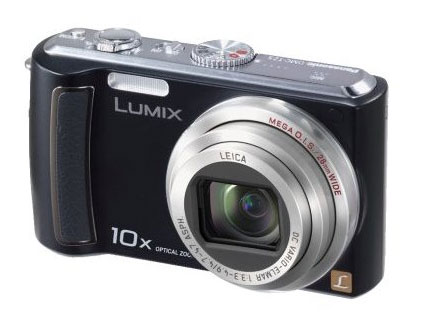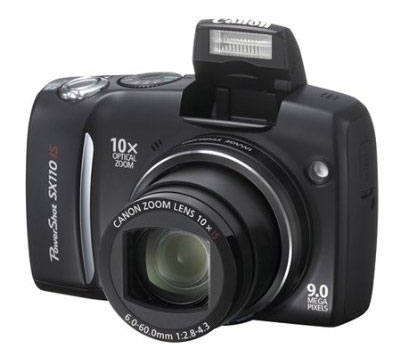Digital Cameras for the Holidays
by Wesley Fink on November 27, 2008 12:00 AM EST- Posted in
- Digital Camera
Superzooms
When point-and-shoot was king of the digital market and the Digital SLR was only in the hands of the pros, there were all kinds of sub-segments in the point-and-shoot market. However, today the lines have become so compressed with DSLR prices dropping that there are really just two P&S categories. There is the entry, or all-around, point-and-shoot and the superzooms, with very wide optical zoom lenses.
Our strong opinion is that it is ludicrous to spend more than around $250 for a point-and-shoot camera today, with the prices of the much more versatile DSLR and the new category interchangeable lens digital starting at $400 to $500. That still leaves a hole from about $250 to around $600 that we think will get quickly filled with large sensor point-and-shoots using micro 4/3 and interchangeable lens mirrorless cameras based on similar large sensor technology.
For those reasons, we have held our top picks for superzooms to around $250. You can certainly spend more if you want that 18X Leica zoom on the Panasonic Lumix DMC-LZ18, but you won't find that camera in our superzoom picks.

Panasonic has developed a well-deserved reputation as a premier provider of superzoom P&S cameras. The Panasonic Lumix LMC-TZ5 is a great successor to the best-selling LMC-TZ4. It features the same superb Leica 10X (28-280mm) true wide-angle zoom as the TZ4, and resolution has been upped a bit to 9.1MP. Every feature Panasonic could think up has been lavished on the TZ5, including Mega OIS stabilization, 3" 460,000 pixel LCD, a very wide 100-6400 ISO range, and a 720p (1280x720) movie recording option.
The TZ5 has a wide range of Auto and Scene modes for excellent flexibility. However, like the previous models, Panasonic has not included Manual controls, so the TZ5 is clearly aimed at the point-and-shoot crowd only. We doubt that many will object. The TZ5 has no viewfinder and does everything on the LCD, which may or may not matter to you. For a little less money, you can find the capable TZ4 with 8MP or a little more money will get you the 18x 10MP TZ28.

Canon point-and-shoot cameras have a reputation for very good image quality, and the Canon SX110 IS won't disappoint you. This update to Canon's SX100 IS ups the resolution to 9MP and the screen from 2.5" to 3". The 10X zoom goes longer than the Panasonic at 36-360mm, but it is missing the true wide-angle that is very useful for shooting indoors. Where the Canon shines, however, is in control, where it offers P, S, A, and Manual options and everything you need to control the camera when you choose.
The Image Stabilization is particularly effective on the SX110 IS, which is a good thing because you will need it to handhold 360mm. You can usually find the SX110 IS a little cheaper than the Panasonic DMC-LZ5, so if lowest price is a huge factor the SX110 IS can save you a few dollars.










41 Comments
View All Comments
Flyboy27 - Friday, November 28, 2008 - link
Nikon D40. Seriously why would I need anything with more MP. Talk about fast and easy to use. Size and weight are very reasonable too. I can turn it on and take a picture before your p/s warms up.Flyboy27 - Friday, November 28, 2008 - link
I would like anandtech to have a serious discussion about magapixels. Why do higher megapixels matter? For web? no! The only way MPs matter is if your printing huge and by huge I mean greater than 20x30. How many times do you need prints that big anyways. Anyone that wants ultimate resolution is going to shoot film anyways. Film can be scanned by a professional lab at higher resolution than any DSLR can take. Just because you have a 20MP camera doesn't mean that you can resolve all those pixels anyways. My point? It is dumb to pay more for more megapixels. Any modern digital camera has enough MPs for any amateur and most pros.WTF is pro-sumer? = amateur photo geek with money. I doubt that pro photographers read this site for advice on cameras. They know what they want already.
All this said (if you want an upgrade from the D40) I think the D90 by Nikon would be a great camera if you want to go that route. It is not worth paying more for any other camera.
I bought a DSLR for the ability to learn to use an SLR camera without having to pay for film. I can learn from my mistakes instantly instead of waiting for film to be developed/scanned. If I already knew how to use an SLR and was comfortable I would be shooting 35mm film and getting it scanned at a much higher resolution than any digital camera.
Wesley Fink - Saturday, November 29, 2008 - link
If readers want to look a little deeper at sensor resolution, sensor size, and noise, take a look at our two part series on the Digital Sensor in The Digital Sensor: A Guide to Understanding Digital Cameras at http://www.anandtech.com/digitalcameras/showdoc.as...">http://www.anandtech.com/digitalcameras/showdoc.as... and The Digital Sensor: Part 2 at http://www.anandtech.com/digitalcameras/showdoc.as...">http://www.anandtech.com/digitalcameras/showdoc.as....Flyboy27 - Saturday, November 29, 2008 - link
Thanks Wesley,I wont go into Digital vs. Film. That is something that a person can only decide for himself. I've already gone into my reasons why I shoot digitally. Besides its all about getting great pictures right? It is my belief that you can get great pictures from most of the cameras out there. Some cameras just make it easier to take more great pictures.
Now my beef with resolution. Just as you have to sit close enough to a 1080p TV at a given size to tell the difference between it and a 720p set the same goes with digital photography. You have to ask yourself "What am I doing with these pictures that I'm going to be taking?" Am I going to make wall size prints? probably not. Am I going to make 20x30" prints? Maybe a few. Am I going to make 5x7s or 12x18s. Definitely. Am I going to use these photos on the web? Most Definitely. These are my answers and yours may be different but based on mine all I'll ever need is 6-10 mp. Fantastic, I don't have to pay extra for more mega pixels just because all the marketing says I do. Marketing tries it's hardest to make you go out an buy more than you need because they have to make money in order to make more cameras and stay in business.
I do take issue with Norman Koren's test. In the test he scanned the film with a $700 scanner. Big deal. He just wiped out any advantage that film might have. He's comparing a digital camera with a scanner, not film. Once again I'm not saying film or digital are better than one another. Pros use both.
I will check out Clark looks interesting and very technical.
I do love anandtech. Quality articles, objective testing. I've recently stopped reading another site due to the slow decline in the quality of their articles/publishing philosophy. Anandtech is now my main source for news and advice on computer hardware. Plus you actually respond intelligently to commentators and most of the commentators comment intelligently as well. Thanks guys.
Wesley Fink - Saturday, November 29, 2008 - link
Can you please provide the source for your information that film has higher resolution than any digital sensor? There are many experts who disagree with you.Norman Koren, the author of Imatest, which is a well-respected Resolution Test Suite, found the resolution of the top films to be equivalent to an 8.3 megapixel full-frame DSLR sensor at http://www.normankoren.com/Tutorials/MTF7.html">http://www.normankoren.com/Tutorials/MTF7.html. Clark at
http://www.clarkvision.com/imagedetail/film.vs.dig...">http://www.clarkvision.com/imagedetail/film.vs.dig... found that Fuji Velvia 100 and 50 were equivalent to a 10 megapixel sensor for intensity detail, and perhaps a 16 megapixel sensor for color detail. All other films he tested, including slide films, were lower in resolution. You can find charts for a wide variety of films at that link.
Clark's final conclusion was 10 to 16 megapixels were the equivalent range of the various film types. Since his work was mostly APS-C sensors it is not really at odds with Koran's tests.
Every other researcher who has tested has generally found 12 to 14 megapixels the equivalent of 35mm film. The larger resolution sensors do show any faults of your lenses and they require the very best glass to resolve those high resolutions.
We did discuss the relevance of megapixels in the article in the discussion of P&S cameras. Our recommendation was that cameras with these tiny sensors - 1/10 to 1/20 the size of an APS-C sensor - have reached the best balance of resolution and noise at around 7 to 9 megapixels. Anything more than this is a waste with these tiny sensors TODAY, but that could change with new sensor technology.
However, in the APS-C sensor the resolution trade-off probably is somewhere around 20 to 25 megapixels with current technology and somewhere around 40 to 50 megapixels in full-frame. Since the sensor is an Analog device that gathers light and converts it to digital info the physical size of the pixel is the most important specification for judging ISO range and noise.
Prosumer is a designation used by almost every camera review site. It is the same as Advanced Amateur. It basically means a class of cameras geared to the hobbyist or advanced amateur that is also used by some Pros. The lines have become particularly blurred as sealing has improved in this class and technical advances have accelerated in digital imaging.
computerfarmer - Friday, November 28, 2008 - link
Nikon D40 is a good camera with 6mp. Then there is the Nikon D40x with 10mp. Both have 23.7 x 15.6 mm CCD sensors. The D40x has ISO 100 and the D40 does not, it starts at ISO 200. The D60 has very little on the D40x and in some cases the D40x is better.You are correct in the fact the D40 will do the job and very well at that.
Nehemoth - Friday, November 28, 2008 - link
I would like to get one new camera bellow the 200US mark, but I don't like the cannon design and I would like that only use 2 AA batteries (so some fujifilm are out), also I like the aesthetics of those old cameras, like DSLR design.Any recomendation?.
computerfarmer - Friday, November 28, 2008 - link
The FujiFilm FinePix S700 has the DSLR look and is selling for 179CDN. It uses 4 AA batteries and has a 10x zoom. you can read user comments herehttp://www.dpreview.com/reviews/read_opinions.asp?...">http://www.dpreview.com/reviews/read_opinions.asp?...
Good luck
Nehemoth - Friday, November 28, 2008 - link
That's what I said before, I don't want fujitsu cause use 4 batteries, I would like of just 2 batteries.ubiloo - Friday, November 28, 2008 - link
I've been shooting since more than 20 years, I've used a lot of cameras from Canon, Nikon and Pentax.Even though the Pentax lacks a full-frame camera (shame! shame!), I'm deeply convinced of the fact that some current models really are among the best for the price. Why is Pentax so often absent from parades?
In particular, I think that the K200D is terrifying for its street price (I don't know about the K-m); I've now been using it for some time and it's a real solid camera with good, sometimes very good, picture quality. I bought it for at least €100 than any comparable camera. This particular model also deletes one of the drawbacks of previous models: with its kit lens, the auto-focus speed is really convincing, try to believe!
As for lenses, both Sigma and Tamron are available, so whenever Pentax is weak, they deliver...